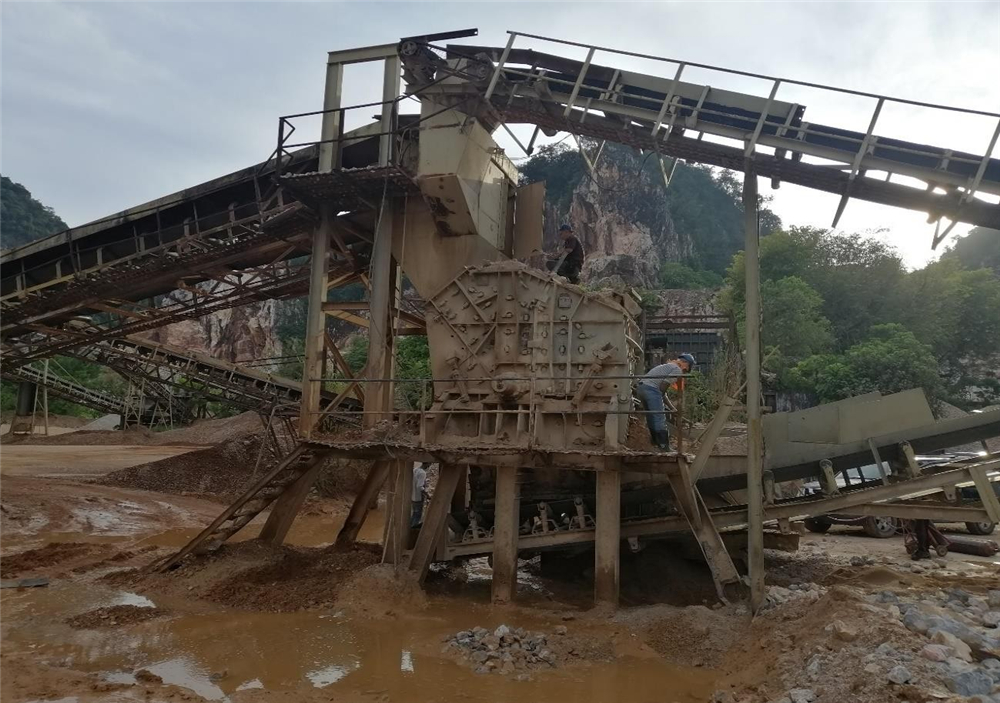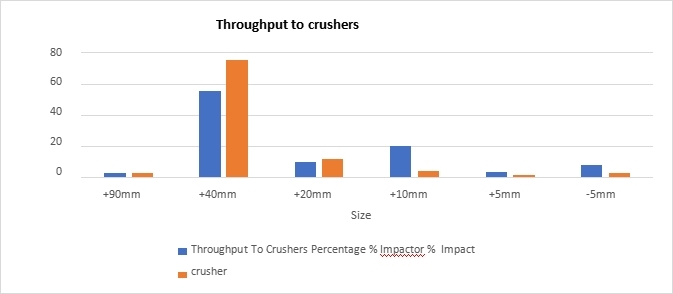1. Introduction
A typical stone crushing operation for a lime operation includes a primary and a secondary crusher. A common primary crusher installation consists of a jaw crusher equipped with a grizzly feeder to bypass fines. Secondary crusher normally consists of cone/impact type crusher in closed loop with a screening system. The throughput capacity of crushers is most related to the physical size of the machine. Increasing the physical size of the machine also increases the maximum size of the material the crusher can process. The reduction ratio also affects the production rate. Running a crusher faster or at a higher rpm is not a viable option to increase throughput.
The second item of importance to a crushing operation is the maximization of the percentage of properly sized stone for use in the calcining operation. This is defined as the yield of the crushing operation. Yield is the percentage of the total amount of stone processed that is properly sized and available for calcining. The ideal situation is to maximize the yield at the maximum throughput rate of the crushing operation. This ideal situation is rarely obtainable and a compromise must be achieved that will allow the production of properly sized stone within an acceptable time frame.
Therefore, thorough study in various type of crusher characteristics was carried out and as a result to recommend for replacement of the existing secondary crusher ie. Impact Crusher to Double Roller Crusher which is produced higher yield in properly sized stone.
2. KAP-75N IMPACT CRUSHER
As rock slide down the chute they are powerfully struck by the rotor's rapidly rotating blades.Thrown up tangentionally, the rocks hit the impact plate and are crushed; they then bounce back collide with other rocks for further crushing. By repeating this process over and over,rocks are reduced to the desired size and are then discharged between the impact plate and the striking blades.
A high reduction ratio of 10 to 1 and produced better cubical products but hence increasing unwanted fine materials.
KAWASAKI IMPACT CRUSHER
Model : KAP-75N
Serial No: C1943
Year/Month : 54-5
Net Weight : 23,000 kg
Coarse Crushing : 190-280 t/h
Speed : 295 rpm
Motor Power : 220 kW
Dimension : 3030 X 2100 X 2735 mm
Sieve Analysis
| Throughput To Kawasaki Impact Crusher | |
|
Size |
% |
|
+90mm |
3 |
|
+40mm |
55 |
|
+20mm |
10 |
|
+10mm |
20 |
|
+5mm |
4 |
|
-5mm |
8 |
|
Total |
100 |
Undersize material not being removed from crusher feed that might tendency to cause packing and excessive wear, simultaneously the capacity of crushing dropped.
The size distribution is based on throughput feed to Impact Crusher. Properly sized stone obtaining yield at 68% which consists of 40-90mm & 20-40mm. Whereas the unwanted undersize material contains 32%.

The yeild of kiln feed was below expectations. In order to increase properly sized stone production rate, the physical size of impact crusher simultaneously to be upsized. Thus the primary crusher became a bottleneck to the system where primary throughput rate unable to support secondary crusher.
Therefore, this is not a ideal solution and may incurred larger capital equipment cost in the stone processing plant.
3. TANGSHAN TIANHE 2DSKP90200 DOUBLE ROLLER CRUSHER
The basic concept of the Double Roller Crusher is the use of two rotors with large teeth bullet type in spiral arrangement, on small diameter shafts, driven at a low speed by a direct high torque drive system. Feed materials are sheared and crushed by the teeth on the two rotating crushing shafts. Undersized materials just passes through directly during crushing process due to the structure designed of the toothed roller. Hence Double Roller Crusher possess dual functions of crushing and screening. That's the reason so called as 'Sizer'. The crushing particle size can be adjusted easily by eccentric cup adjustment method.
The reduction ratio of 4 to 1 which can produce high yield in properly sized stone with acceptable cubical products and lesser unwanted undersized materials and fines.
The crushing teeth are casting by high anti-abrasion alloy (HRC 45-55, impact toughness 38kg.m/cm2) that is with characters of high strength, high toughness and high wear resistan

TIANHE DOUBLE ROLLER CRUSHER
Model : 2DSKP90200
Product No : 19201065
Manufacture Date : 27.12.2019
Net Weight : 25,000 kg
Capacity : 300 TPH
Roller Speed : 83 rpm
Motor Power : 2* 110 kW
Dimension : 5682 X 2675 X 1150 mm
| Throughput To Double Roller Crusher | |
|
Size |
% |
|
+90mm |
3 |
|
+40mm |
75 |
|
+20mm |
12 |
|
+10mm |
5 |
|
+5mm |
2 |
|
-5mm |
3 |
|
Total |
100 |

The size distribution is based on throughput feed to Double Roller Crusher. Properly sized stone obtaining yield at 90% which consists of 40-90mm & 20-40mm.Whereas the unwanted undersized material only contains 10%.
By using Double Roller Crusher as a secondary crusher, the yield of properly sized stone obviously increased and hence crushing throughput of Double Roller Crusher also higher than Impact Crusher with same motor power. Thus shorter operating hours for Double Roller Crusher to achieve similar production rate of Impact Crusher.
4. Comparison Of Size Distribution
|
Throughput to crushers |
Remarks | ||
|
Size |
Percentage % |
||
|
Impact crusher |
Double roller crusher |
||
| +90mm |
3 |
3 |
KFS increased 20% |
| +40mm |
55 |
75 |
|
| +20mm |
10 |
12 |
KFS slightly increased 2% |
| +10mm |
20 |
5 |
Undersized decreased 17% |
| +5mm |
4 |
2 |
|
| -5mm |
8 |
3 |
Fines decreased 5% |
|
Total |
100 |
100 |
|

5. Conclusion
Impact crusher: final material 40-90mm, 20-40mm 68%, ultra-granular material accounted for 32%
Double-toothed roller crusher: 40-90mm and 20-40mm 90%. The proportion of unneeded particle size and too small particle size material is only 10%
The understanding of the interaction of the crushers and knowledge of crushing principals allows operators to implement practical low cost solutions to optimize an operation. Using these principals, the case studies demonstrate how system throughput can be increased while at the same time the yeild of the quarry can be increased. Improving the yield positively impacts an operation because it extends the life of the reserves, lowers the cost of raw materials while reducing waste.
Post time: Jul-11-2022
